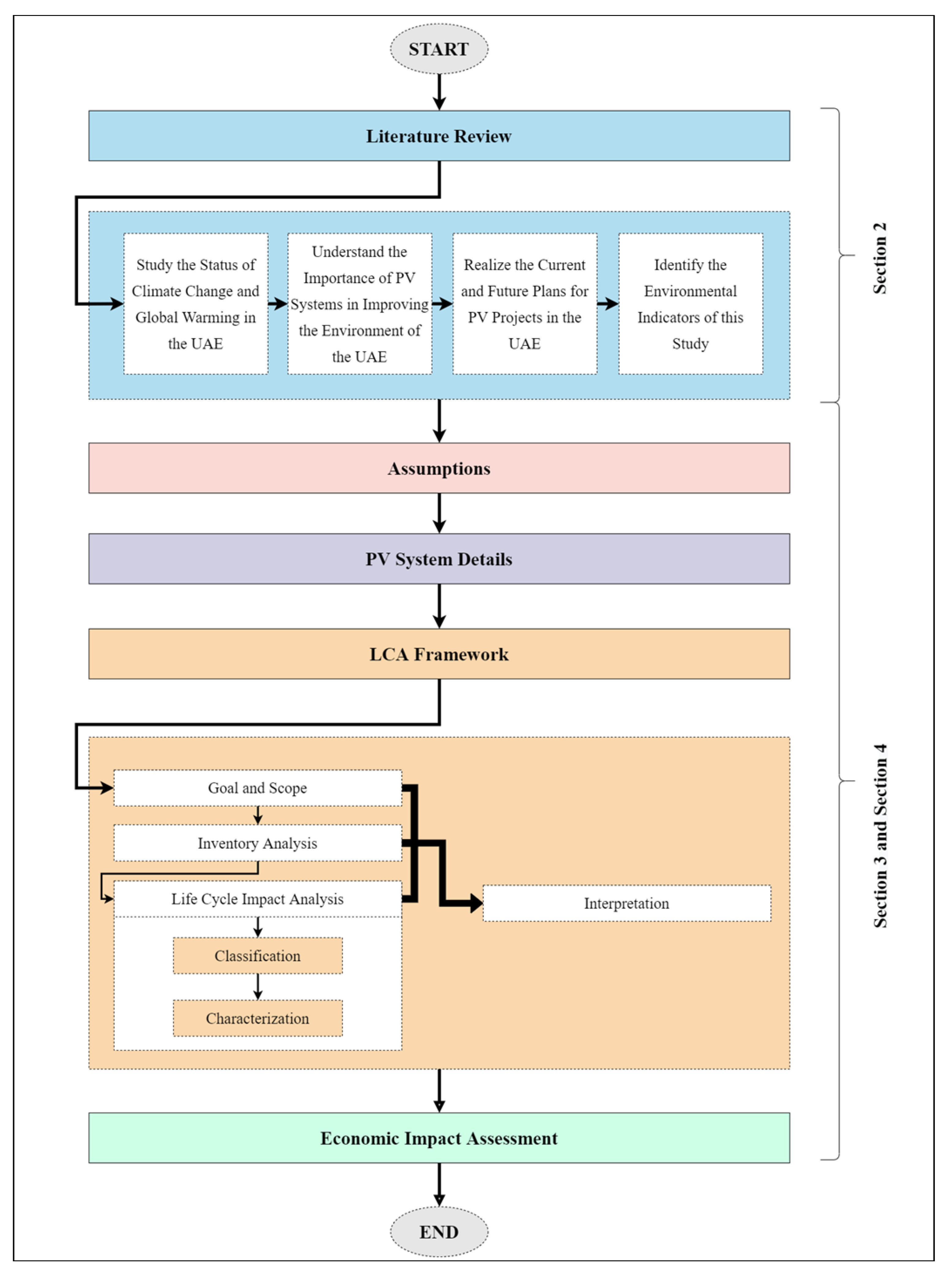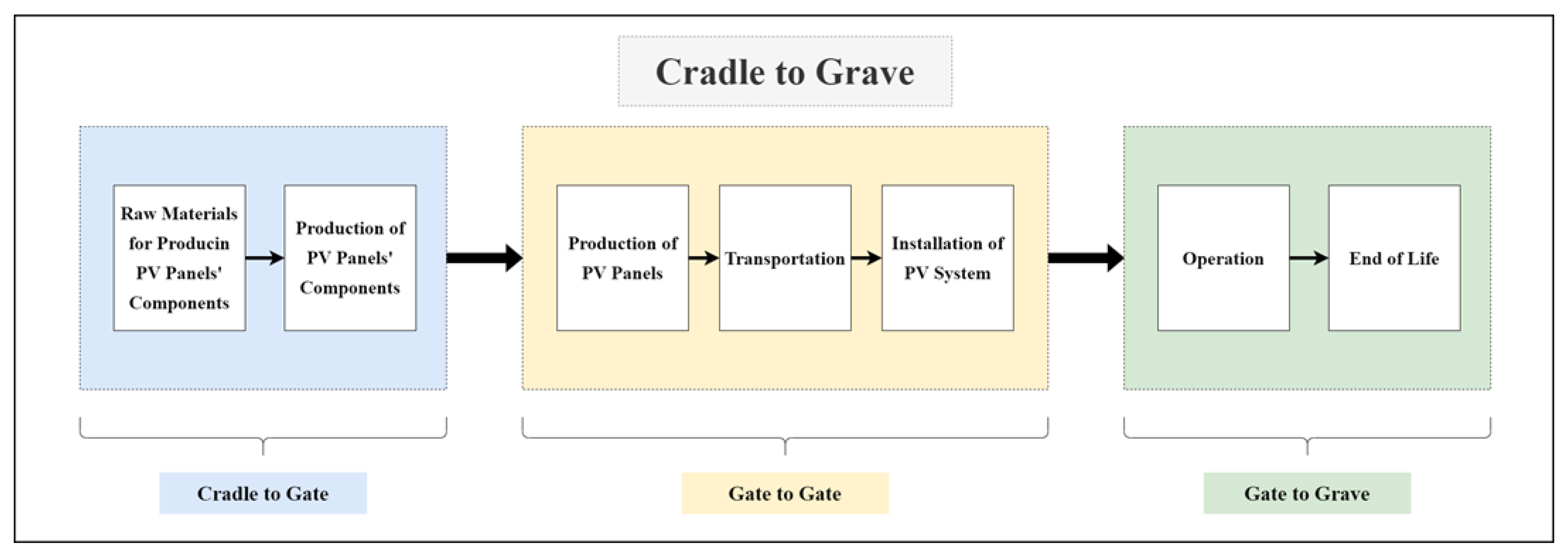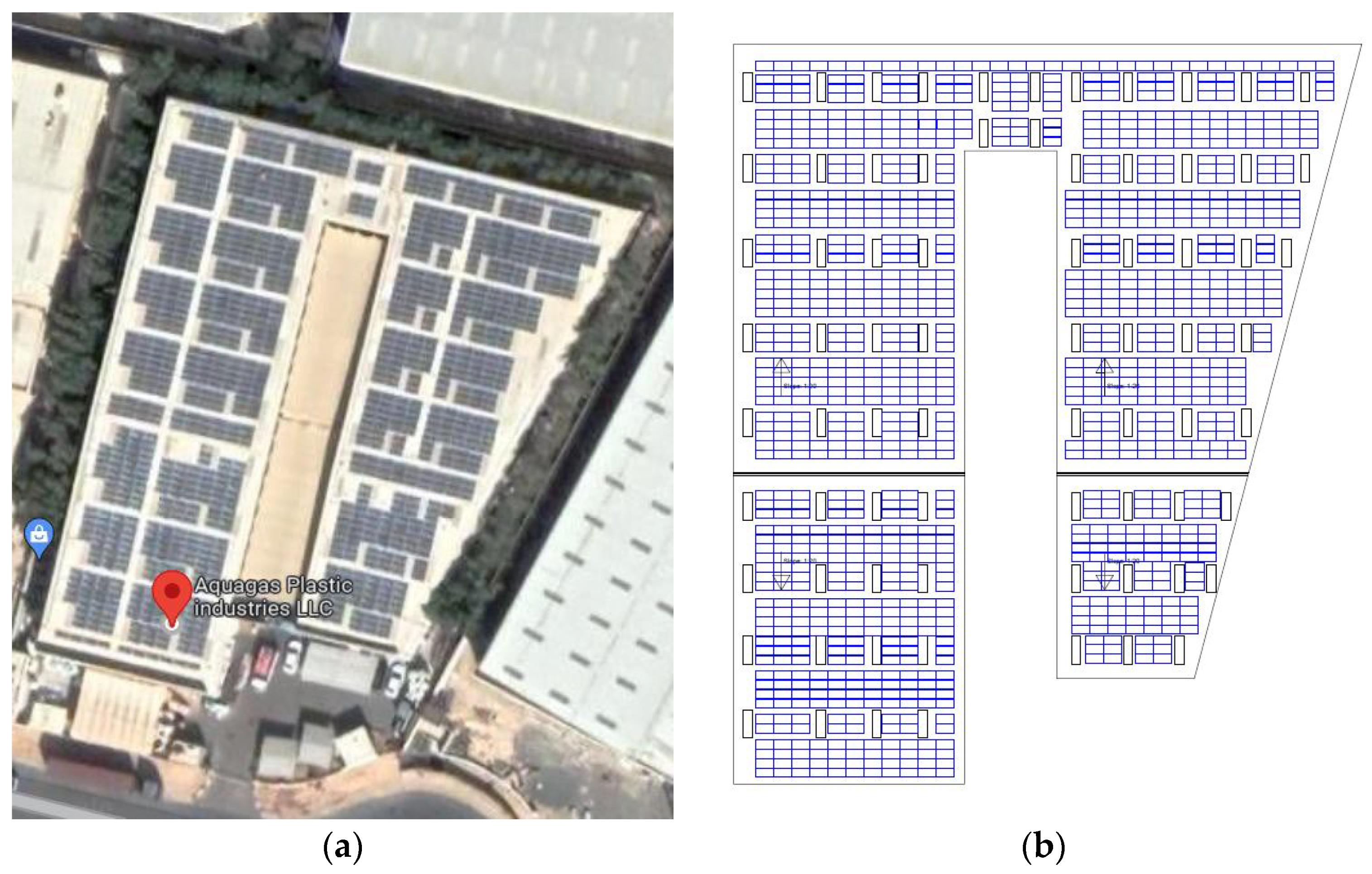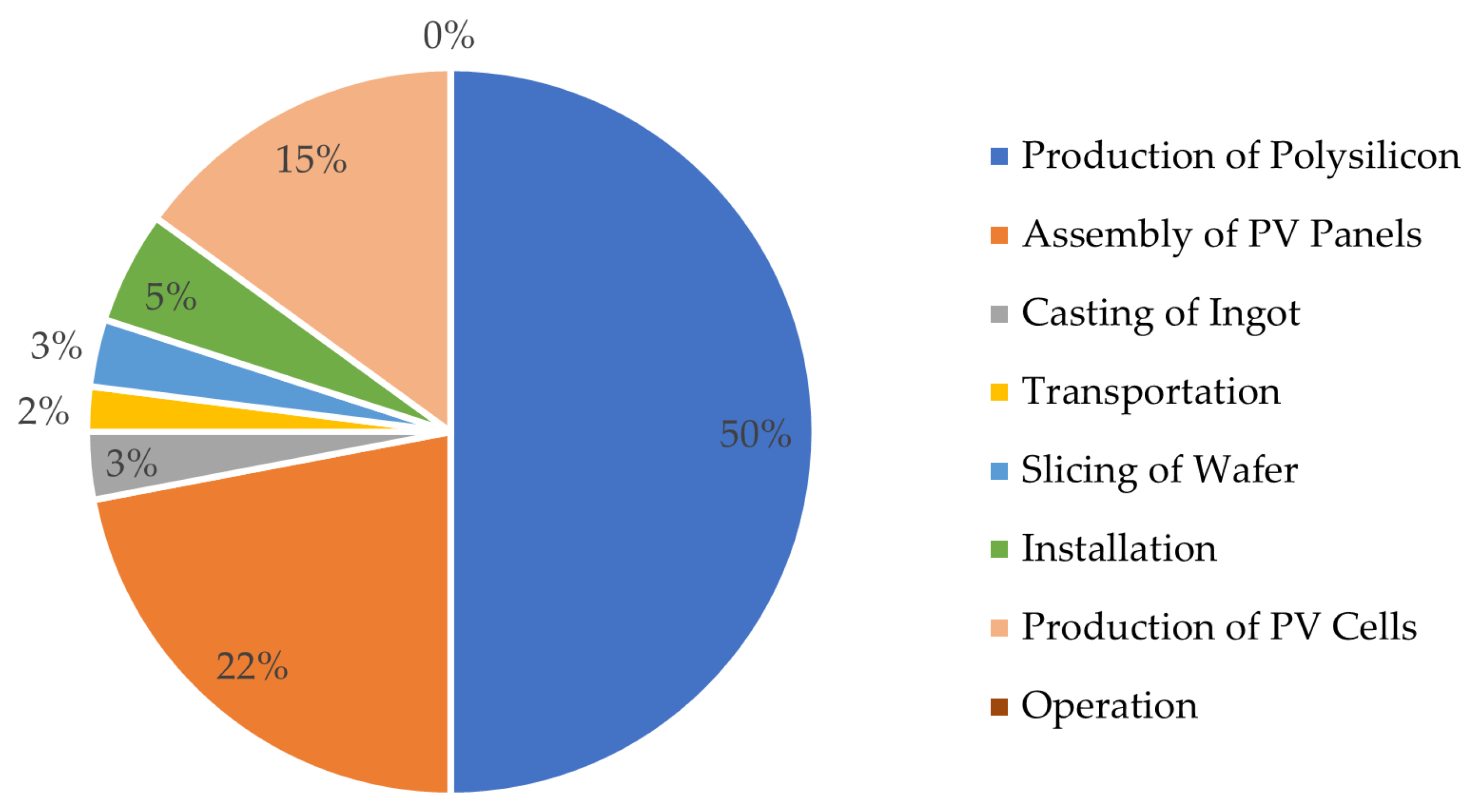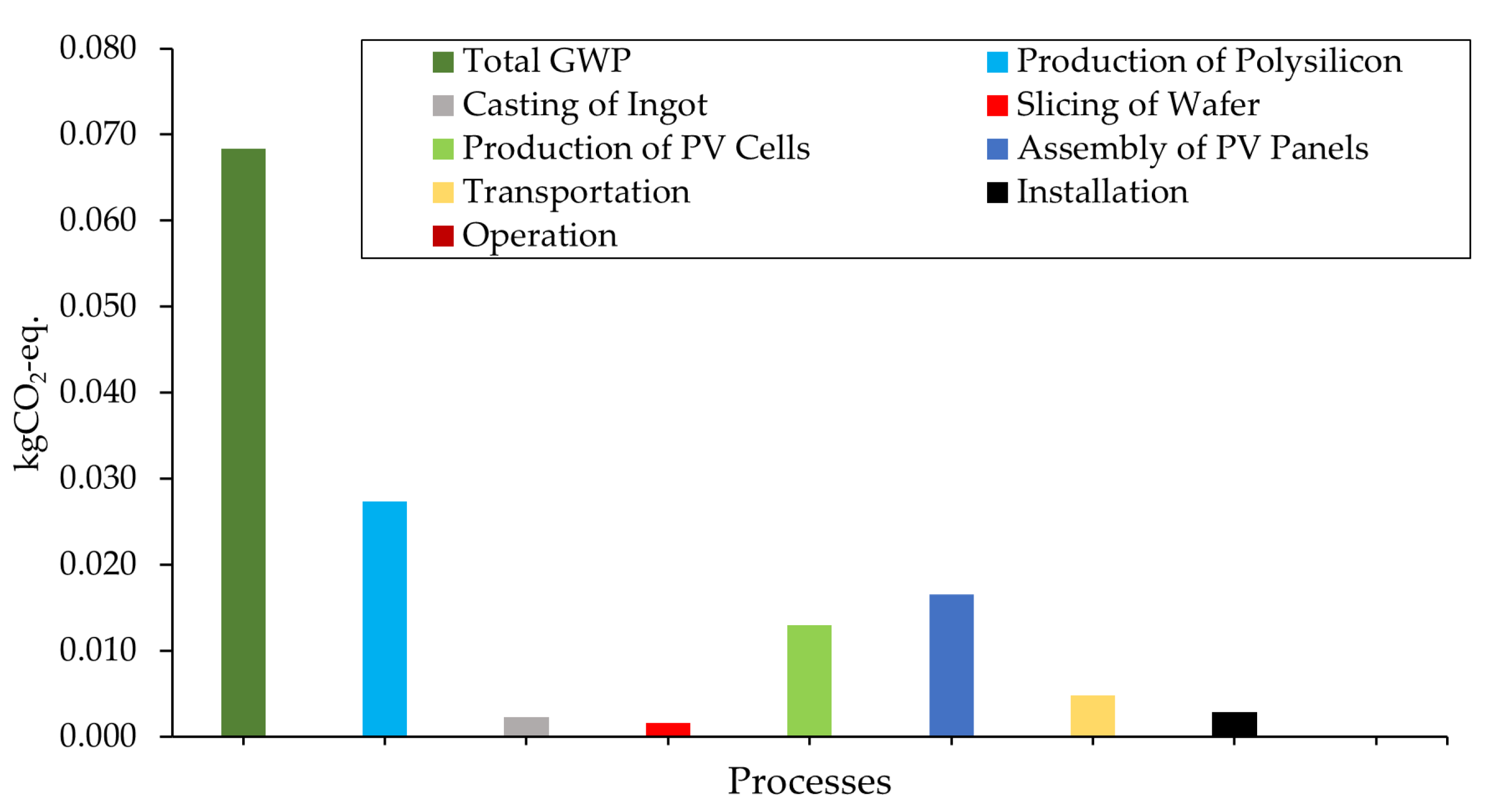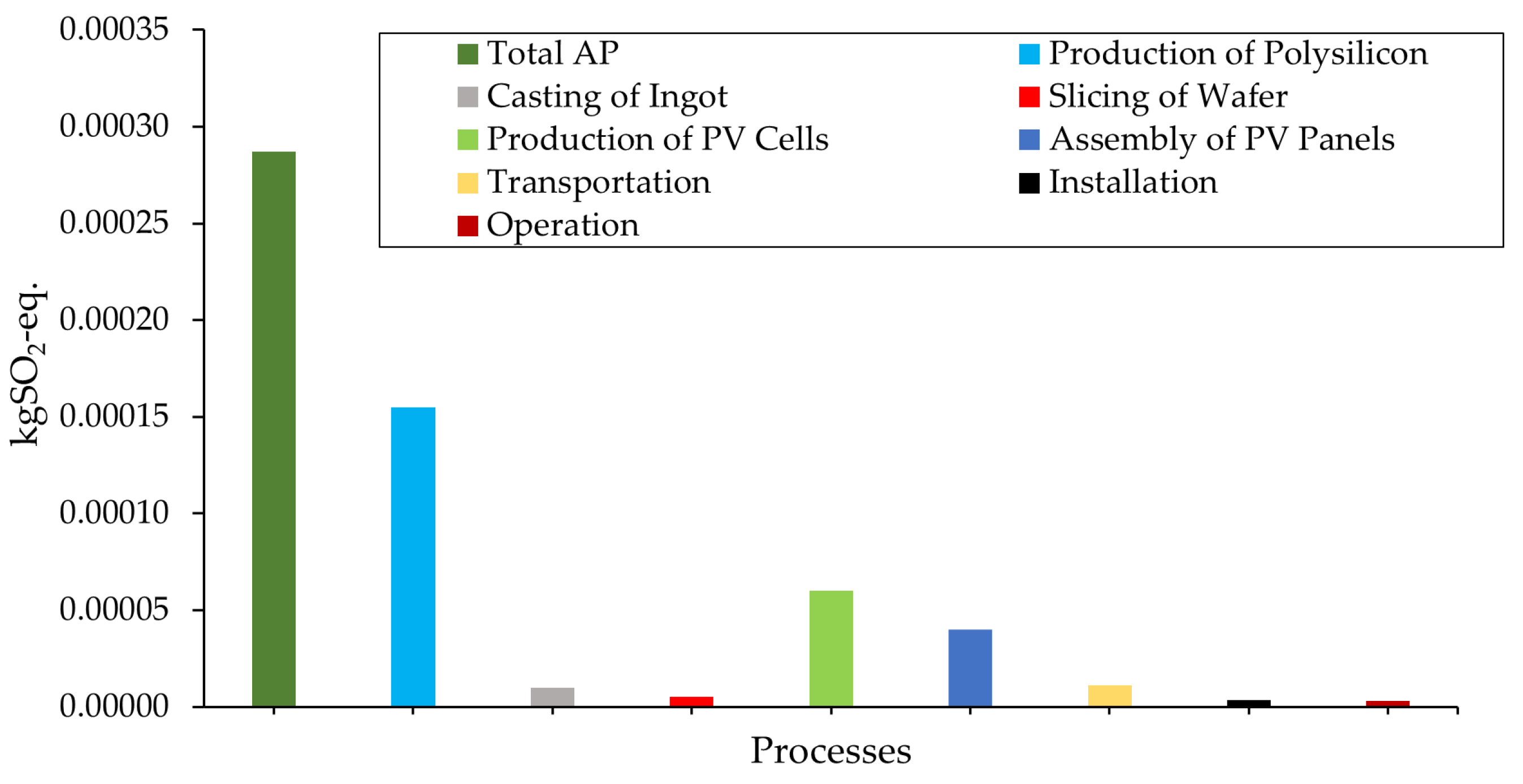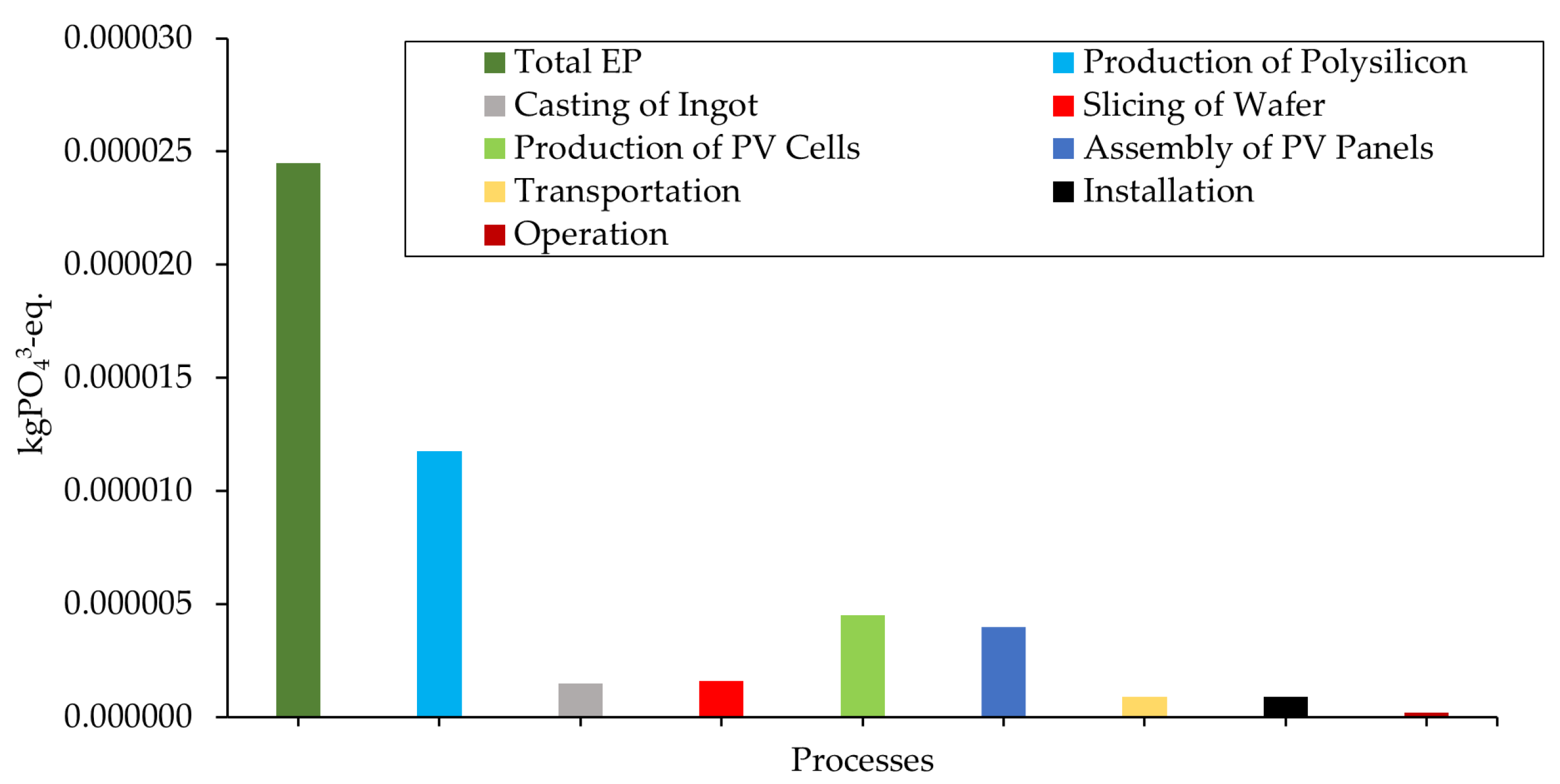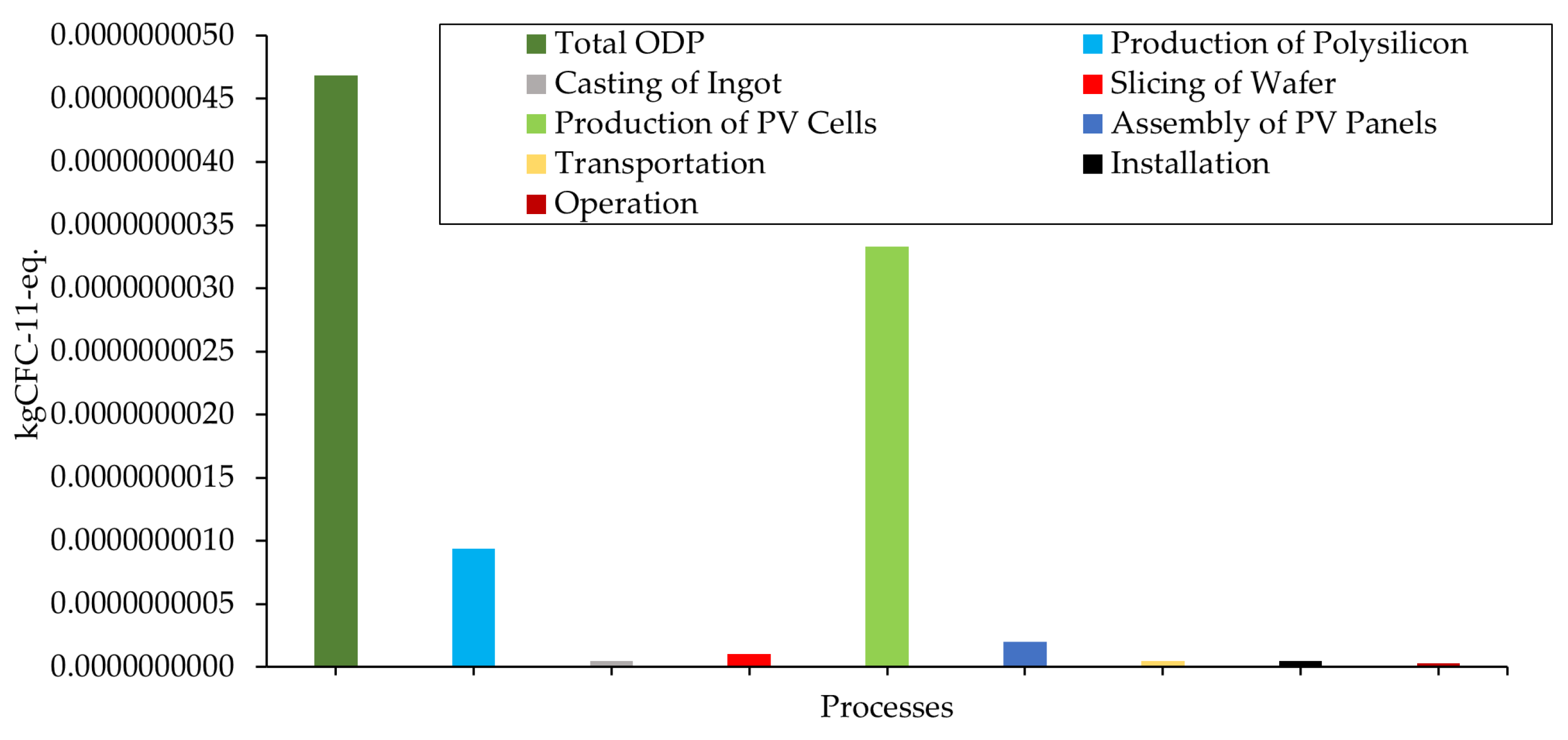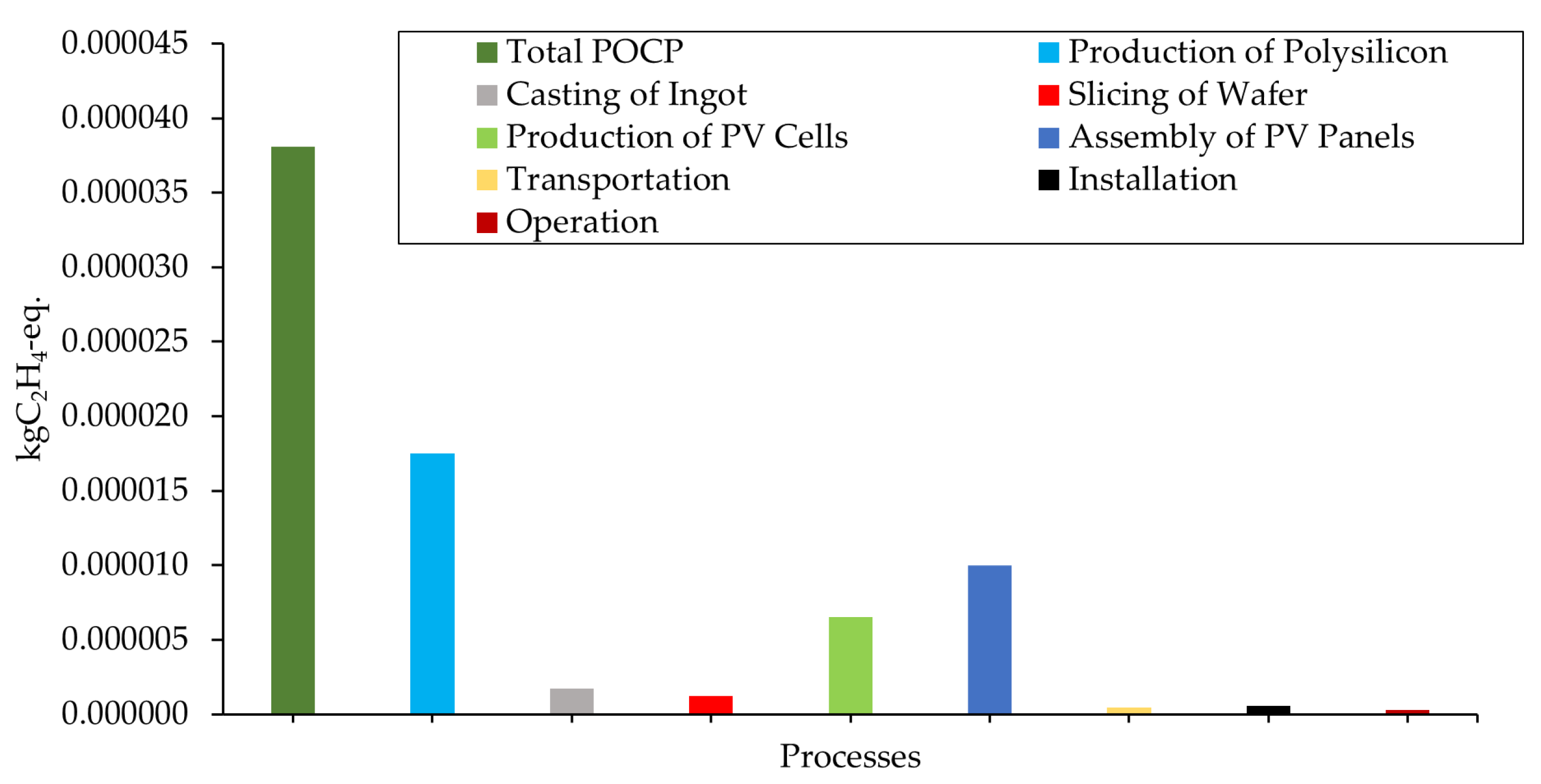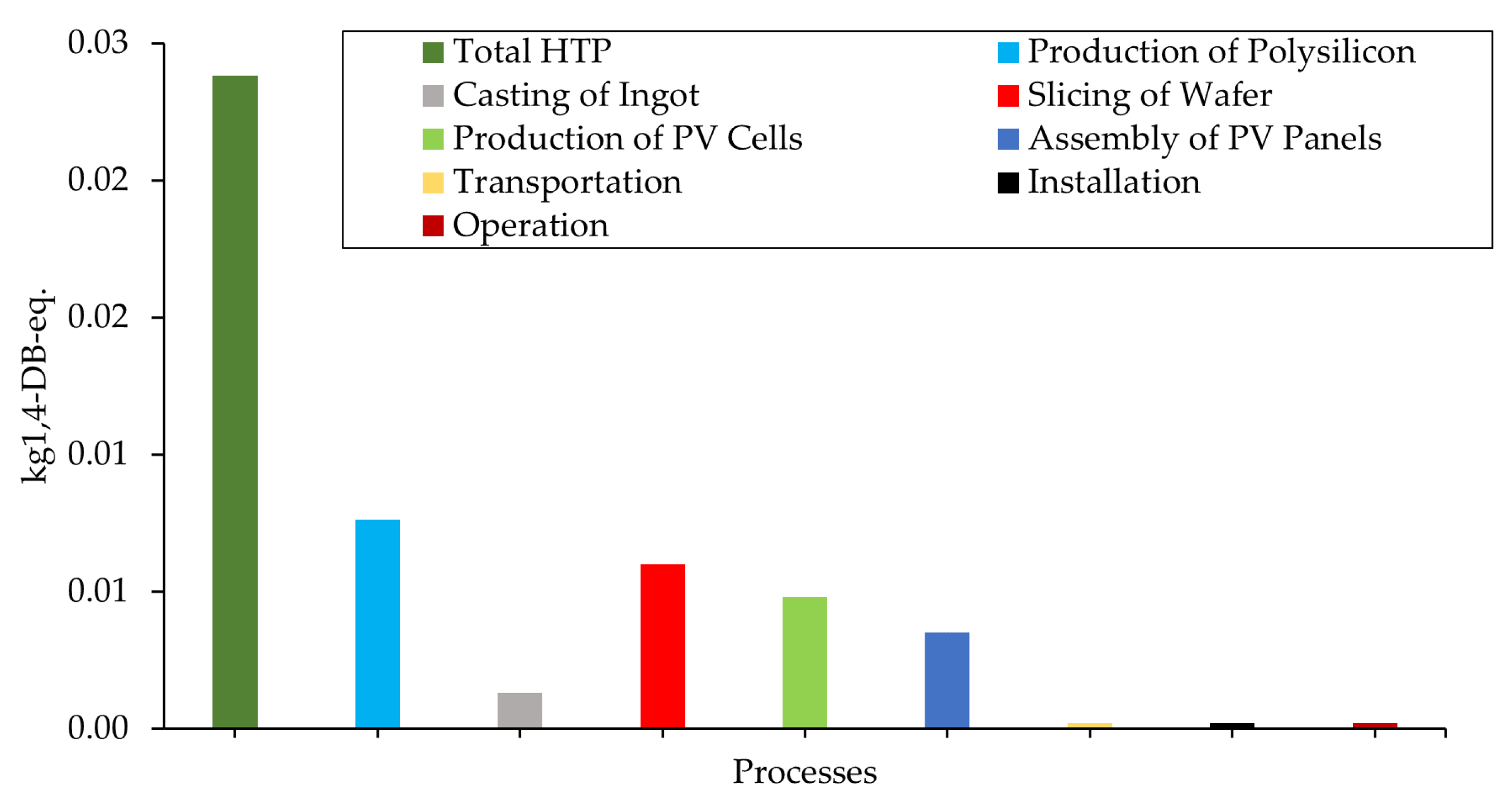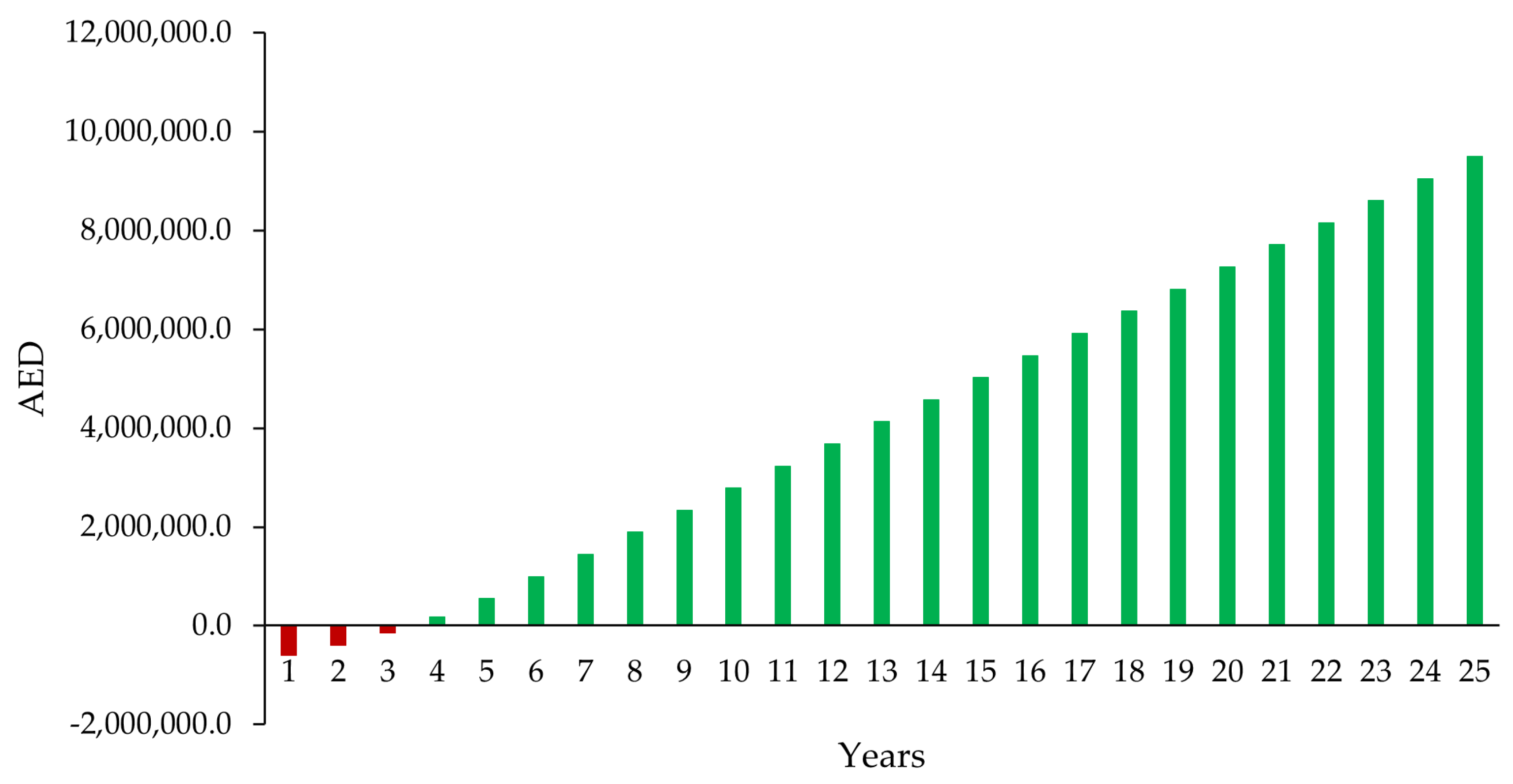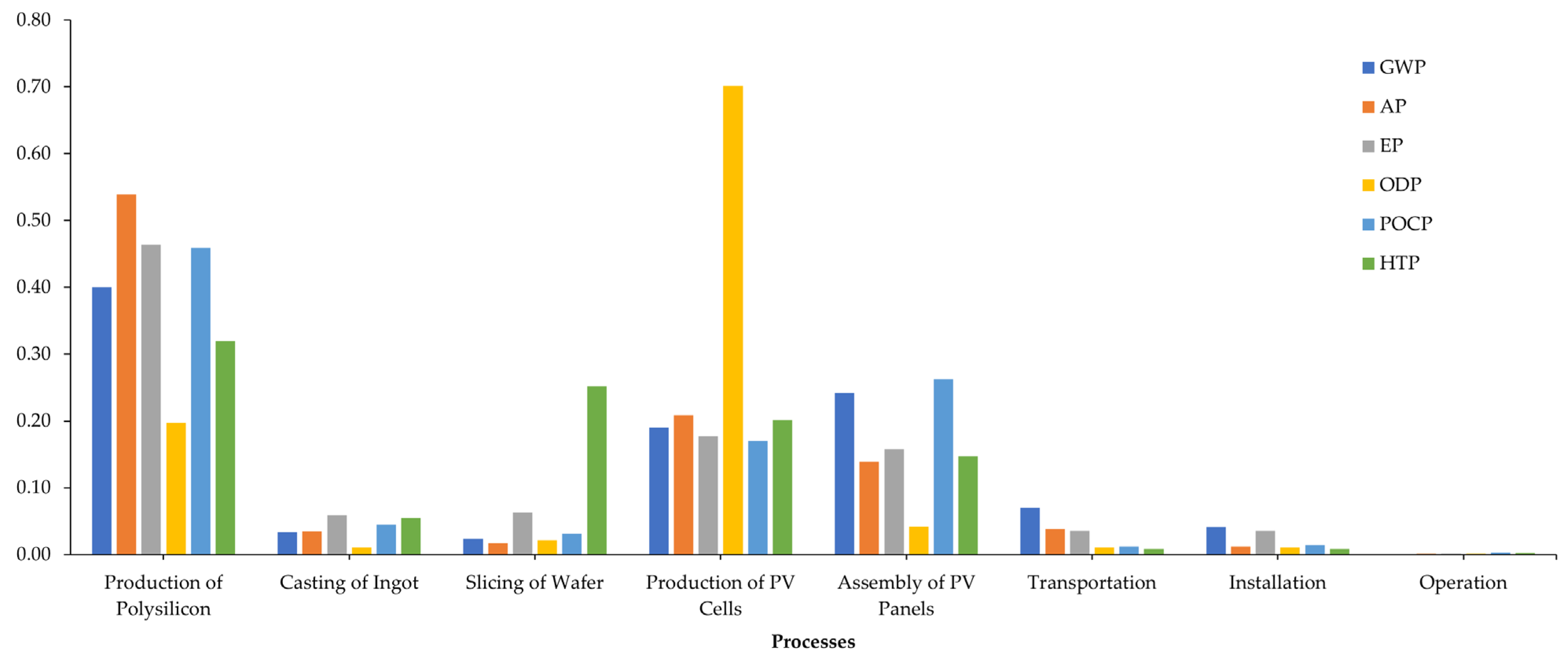1. Introduction
Electricity consumption is an indicator of the industrial and economic growth for countries. This is apparent in China, which has the greatest contribution of the world’s industrial production, with an approximate contribution of 28% in 2019. The increase in global electricity demand from 1990 to 2019 was 228% [
1], but it is forecasted by the International Energy Agency (IEA) to increase by more than 50% in 2030 [
2]. The harmful environmental impacts of this continuously increasing demand are inevitable with the current main dependence on conventional energy resources [
3] such as climate change and global warming due to massive greenhouse gas emissions. Thus, the dependence on renewable and clean energy resources has become one of the top priorities and visions for all countries [
4].
Consequently, governments worldwide have invested significantly in regulating and adopting renewable energy resources to mitigate the risk of global warming and enhance the quality of the environment. Additionally, based on the current achievements and potential plans in generating electricity from renewable resources, the contribution of these resources is expected to reach 50% of the total energy generation between 2020 and 2025 [
5]. This can be noticed from the published statistics by the International Renewable Energy Agency (IRENA) on the global trends in renewable energy from 2010 to 2020, which approached an ~2800 GW installed capacity in 2020 [
6]. Additionally, the largest contributing regions in renewable energy projects are in Asia, which has 45.95% of the global total installed capacity with 1286 GW [
7]; this is because China is the largest consumer and has put numerous efforts to decrease the use of conventional resources and depend on renewable resources.
Solar energy is a type of renewable energy resource that is plentiful, inconsumable, free, and safe [
8]. Furthermore, it is known for its simplicity and effectiveness compared to other resources [
9], in addition to the evolving technology that has led to a remarkable reduction in costs and promoted the use of solar energy [
10]. The total contribution of solar energy is expected to reach 31% of total renewable energy resources in 2030 [
11]. The latest updated statistics in 2020 showed that the top ten countries that contributed the most to the installation of solar energy projects were China, the USA, Japan, Germany, India, Italy, Australia, Vietnam, the Republic of Korea, and Spain.
Although there has been a noticeable shift toward renewable energy, the impact of climate change is still a global challenge and a major environmental risk. The main impact of climate change is global warming [
12], which refers to the slow and gradual increase in the temperature of the Earth’s atmosphere due to the increase in the heat hitting the Earth from the Sun and being trapped in the atmosphere (infra-red radiation) instead of being radiated into outer space,, which happens due to greenhouse gas emissions [
13].
Greenhouse gases include several gases such as carbon dioxide (CO
2), which is the most popular gas as it is common and usually used to measure the global warming and other environmental impacts. It mainly results from burning fossil fuels, tree products, solid waste, and soil degradation, fluorinated gases including perfluorocarbons and hydrofluorocarbons, which are long-lasting and very warming gases, and result from several household, industrial, and chemical activities. Methane, which has a warming effect that is 28–36 times the effect of CO
2, results from the production and transportation processes of natural gas, oil or coal, the anaerobic decay of organic waste, livestock, and agricultural practices, nitrous oxide (NO
x), which lasts for long period of time in the atmosphere, the combustion of fossil fuel and soil waste, industrial activities, and agricultural practices. Sulphur hexafluoride, which lasts for thousands of years in the upper atmosphere, is used in specialized medical procedures and water vapor [
12,
13,
14,
15]. Another component that causes global warming is black carbon (BC), which are very small carbon particles (PM
2.5 and PM
10) that result from the incomplete combustion of biofuel, fossil fuels, and biomass. These particles can absorb the heat of the Sun a million times more than CO
2 [
12]. However, several sectors contribute to greenhouse gas emissions, but the energy sector is responsible for approximately 72% of the total greenhouse gas emissions and 31% of the energy sector demand is to generate electricity and heat from non-renewable resources [
16]. This highlights the importance of focusing on using renewable energy resources to cover the electricity and heating demands.
In the context of the United Arab Emirates (UAE), electricity consumption is rapidly increasing with an overall growth of approximately 310% in the past twenty years [
17]. While dependence on renewable energy resources took place in 2013 with a noticeable boost in 2019 [
18], such a boost was attributed to the proven feasibility of the initially installed PV systems accompanied by the rapid increase in the registered PV contracting companies, which led to significant growth in the market of PV systems. In addition, numerous milestones have been adopted and achieved by the UAE regarding the renewable energy sector such as having the headquarters for the International Renewable Energy Agency (IRENA), hosting the annual World Future Energy Summit, establishing the Emirates Nuclear Energy Corporation (ENEC), and launching the Energy Strategy 2050, which aims to increase the share of clean energy by 50% [
19]. Furthermore, the UAE’s greenhouse gas emissions per capita have reached 21.26 tons, where electricity and heat are the main contributing sectors with a total share of 88.2 million tons [
20].
To evaluate PV systems worldwide, it is crucial to evaluate the energy generated by these systems, the energy consumed throughout the life cycle of these systems, and their environmental and economic impacts. This can be achieved by conducting a life cycle assessment (LCA), which is a standardized and systematic method for calculating the environmental impacts during the life cycle of systems [
21,
22,
23]. In addition, LCA helps policy and decision-makers by mapping and highlighting the environmental impacts and the main contributors to the global warming problem [
22,
24,
25,
26,
27].
As the UAE moves toward a net zero strategy, this paper aimed to assess the environmental and economic impacts of a PV system using several environmental and economic indicators such as the CO
2 payback time (CO
2PBT), energy payback time (EPBT), global warming potential (GWP), acidification potential (AP), ozone layer depletion potential (ODP), human toxicity potential (HTP), photochemical ozone creation potential (POCP), eutrophication potential (EP), payback period (PBP), benefit to cost ratio (BCR), and levelized cost of electricity (LCOE) using as a case study a multi-crystalline (poly) PV system installed on a rooftop of an industrial facility in Dubai, UAE. The rest of this paper is organized as follows. A literature review of the relevant studies is presented in
Section 2, followed by the methodology in
Section 3, then the results are summarized in
Section 4.
Section 5 includes the discussion, and finally,
Section 6 includes our conclusions and future work.
2. Literature Review
A LCA is “the compiling and evaluation of the inputs and outputs and the potential environmental impacts of a product system during its lifetime”, as defined by the international organization of standardization (ISO) [
28,
29], where inputs represent the required resources and outputs are emissions to air, soil, and water. LCA helps in determining the environmental hotspots throughout the life processes and accordingly assists in improving the processes and making them more environmentally friendly.
The first research work that studied the environmental impacts of PV systems was back in 1970 by [
30], where the total energy used to produce PV solar cells was assessed, and it was concluded that the EPBT for monocrystalline PV solar cells was 12 years, which was almost half its lifetime (25 years). Most of the conducted studies focused on greenhouse gas emissions and their consequences on the environment, especially their impact on climate change and global warming [
31,
32,
33]. For instance, [
34] assessed the life cycle of a PV project and found that the greenhouse gas emissions would approximately reach 16g CO
2-eq/kWh over 50 years, while the EPBT for the same project was 0.9 years, which was less than 3% of the project’s lifetime. Furthermore, different production processes of PV panels result in different environmental impacts that might be related to the raw materials used, the technology used, or manufacturing equipment, therefore, some researchers considered particular processes when they conducted a LCA for PV panels [
35,
36,
37].
An interesting recent review paper focused on the life cycle assessment for the generation of three PV panels including silicon-based PV panels, thin-film PV panels, and PV panels that are produced by thin-film cells but using new technologies based on nanometers as well as inorganic, organic, or semi-organic materials [
38]. However, the literature lacks studies that have considered the acidification potential, biological toxicity, or eutrophication potential, and only a few researchers have examined these environmental indicators [
35,
39,
40,
41,
42]. In addition, recovering, recycling, and decommissioning stages were rarely considered in the previously conducted studies [
43,
44,
45].
In addition, [
46] studied the life cycle of a 1.2 kWp PV system using monocrystalline PV panels in Brazil for seven geographically different locations, where the decommissioning stage was not considered. It was found that the CO
2 emissions ranged between 14.54 and 18.68 g deCO
2-eq/kWh, while the EPBT ranged between 2.47 and 3.13 years. However, China, which is ranked as the largest PV panel manufacturer in the world, is currently facing major challenges in the recycling, reusing, or decommissioning processes of PV panels since many large-scale plants have reached their end of lifetime (25–30 years of operation) [
47].
2.1. Environmental Indicators
To assess the environmental impacts of PV systems, EPBT, GWP, AP, EP, CO
2PBT, ODP, POCP, and HTP are the most applicable indicators and were considered in this study.
Table 1 summarizes these indicators, and the following subsections discuss these indicators based on the reviewed literature.
2.1.1. Energy Payback Time (EPBT)
EPBT means the time when the energy consumed in producing, installing, maintaining, and recycling a system is compensated by the energy produced from the system [
22,
44,
48]. For example, if the EPBT of a PV system that has an expected lifetime of 30 years is found to be 2 years, this implies that the needed energy for this system will be compensated in 2 years and the energy generated from the system is free energy for the remaining 28 years [
49]. If the value of EPBT exceeds the lifetime of the PV panels, then the recovery of the energy consumed is impossible [
50]. This indicator is commonly used as it represents the total input to the total output of the system, where interpretation is easily understood [
36]. This has been the focus of several researchers as a result of a life cycle assessment for PV projects and products [
51,
52,
53,
54]. The resulting values of EPBT depend on several criteria such as the location of the system and the conversion efficiency of PV panels (the higher the efficiency, the shorter the EPBT) [
44,
53].
2.1.2. Global Warming Potential (GWP)
The consequences of GWP can be noticed in the form of different natural changes such as tornados, new harmful pests, droughts, diseases, rising sea levels, melting glaciers, etc. [
12]. The quantification and analysis of GWP are carried out by converting each greenhouse gas emission to the CO
2 equivalent value. The main greenhouse gas emissions are CO
2 with GWP = 1, N
2O with GWP = 298, CH
4 with GWP = 25, and chlorofluorocarbon with GWP = 4750–14,400; all these quantities are based on a GWP of a 100 years [
55]. For PV projects, the GWP impact mainly results from the production phase, which requires most of the energy used, however, the raw materials (silicon) can be recovered and reused after the lifetime of the cells [
56,
57].
2.1.3. Acidification Potential (AP)
This is mainly caused by anthropogenic activities and in the context of PV systems, the production process is the main contributor to AP, where the total AP of the PV panels is approximately 57% of the total AP from the PV system [
57]. It occurs when a molecule donates hydrogen ions (H
+), where increasing the concentration of hydrogen ions will reduce the pH of the medium, increase the acidity, and negatively impact the biosphere. AP results mainly from the acidification chemicals that are emitted from fossil fuel combustion including SO
2, HCL, NOx, and NO
3 [
57], and the values of AP differ according to different atmospheric environments and geographical characteristics [
58].
2.1.4. Eutrophication Potential (EP)
Phosphorus, phosphate (PO
43), ammonia, nitrate, and nitrogen are the main contributors to EP, where the increase in nutrients will increase the production of biomass, which, in the case of aquatic systems, makes the water unsuitable for drinking [
23]. Thus, EP damages the freshwater and marine water ecosystems, and it is attributed to the excessive growth of plants and algae as a result of increasing the associated growth factors [
59,
60]. Furthermore, it is harmful to terrestrial animals and plants as it disturbs the food web [
61], affects the biodiversity in ecosystems, and in PV systems, EP is mainly caused by the production process of PV panels [
57].
2.1.5. Ozone Layer Depletion Potential (ODP)
The depletion of the ozone layer makes it thinner and promotes the delivery of ultraviolet B radiation to the Earth, and it takes place every time an ozone molecule is reduced to oxygen. Ozone is important for the Earth’s biosphere as it has benefits at stratospheric altitudes where it absorbs 99% of the harmful incoming UV irradiation, which accordingly protects the life on Earth. Therefore, if the ozone in lower altitudes is decreased, harmful UV radiation will penetrate and adversely impact the biosphere [
57,
59], which is dangerous for ecosystems and humans [
23]. Brominated and chlorinated substances including CH
4, N
2O, and H
2O are the main contributors to ODP, where the risk of these substances lies in the fact that they have a long residence time in the atmosphere, which implies that ozone depletion will happen for a long time after the emissions [
22,
57]. For PV systems, the major contributor to ozone depletion is the production of PV cells [
57]. Furthermore, the consumption of aluminum frames during the assembly process of PV panels is the main contributor to the ozone layer depletion potential, and it has been proven that decreasing the aluminum consumption by 10% during the assembly of PV panels would result in a 7.01% drop in the ozone layer depletion potential [
36].
2.1.6. Photochemical Ozone Creation Potential (POCP)
The photochemical oxidation of volatile organic compounds (VOC) and carbon monoxide (CO) in the presence of nitrogen oxides and UV light creates ozone and other reactive chemicals in the troposphere [
23,
62]. Ethylene (C
2H
4) is the contributing substance to POCP. This indicator has been used by several LCA studies [
63,
64,
65,
66], and it has been proven that POCP has negative impacts on ecosystems, crops, and human health [
23].
2.1.7. Human Toxicity Potential (HTP)
The HTP was initially proposed in [
67]. The direct effect of the HTP occurs when drinking contaminated water or breathing polluted air, while the indirect effect of the HTP occurs when consuming plants or animals that have been affected by toxic substances from the environment. It is the most debated and uncertain indicator in the LCA, and 1,4 dichlorobenzene (1,4-DB) is the reference substance for human toxicity [
23,
68,
69]. The severity of toxic substances depends on several criteria including exposure time and risk, the concentration of toxins, and the physical characteristics of humans [
23,
57]. Additionally, the excavation and processing of cadmium, aluminum, mercury, and magnesium promote spilling them out into the environment and increasing the HTP score [
57]. Additionally, workers and consumers can have direct contact with these chemicals during their working or personal daily time [
70], while for PV systems, the installation process on flat roofs is the main contributor to HTP [
57].
2.2. Economic Indicators
The economic impact category is one of the sustainability assessment measures, and it is investigated before the execution phase to measure the feasibility and profitability of the project [
71]. Although conventional/non-renewable energy resources are relatively cheaper than renewable ones [
72,
73], there is a continuous effort by manufacturers and planners to optimize the cost of renewable energy resources and make them profitable, in addition to providing environmentally acceptable solutions [
74,
75].
To assess the economic impact of PV systems, the generated electricity should compensate for the incurred cost including the capital, installation, operation, and maintenance costs, the levelized cost of electricity should be less than the current cost of electricity from the conventional resources, and the payback period should be as short as possible [
76,
77].
Table 2 summarizes the considered economic indicators in this study, and the following subsections discuss these indicators based on the reviewed literature.
2.2.1. Levelized Cost of Electricity (LCOE)
This indicator is mostly used to compare the cost of the generated electricity from PV projects (after deducting all the paid amounts for the materials, installation, operation, and maintenance) with the cost of electricity from the currently available resources (grid, diesel generator, etc.), which are non-renewable resources [
78,
79]. Accordingly, the lower the LCOE value, the higher profitability of the PV projects achieved and vice versa.
2.2.2. Benefit–Cost Ratio (BCR)
This indicator represents a profitability measure based on cost–benefit analysis, and assesses the economic success of projects by comparing the present generated benefits from the project (as monetary value) to the present incurred costs in the project [
80,
81]. If the resulting value of BCR is more than 1, then the project is profitable, the net present value will be positive, and the internal rate of return will be above the considered discount rate, but, if the BCR equals 1, this implies that the project is neither profitable nor lossy and the expected profits will equal the incurred cost, while a value of BCR that is less than 1 indicates a non-profitable project as the costs are going to be higher than the generated profits [
82].
2.2.3. Payback Period (PBP)
The PBP is one of the widely used indicators for assessing projects [
83], and takes into account the whole invested cost along with the positive and negative cash flows during the project lifetime to assess the profitability and feasibility of projects by knowing the period (in years) where a breakeven point is achieved when the net cashflow compensates the total invested cost [
82,
84].
Based on the reviewed literature, this study earns a significant position amongst the conducted studies as it considers many indicators from both the environmental and economic perspectives, where most of the input and output flows for the production processes considered as the main contributors to the environmental impacts in PV systems were measured directly in the production facilities (primary data), which resulted in more accurate findings in this study.
In terms of publications, there were 631 published studies in the world where environmental impact assessment and LCA were investigated for PV systems as per Scopus research analysis, which is categorized as one of the premium databases and peer-reviewed journals [
85,
86].
Figure 1a shows the conducted studies per year in this area, where it can be clearly noticed that the trend of research continuously increased with an insignificant drop in 2019. Furthermore, most of the conducted studies focused on the energy, engineering, and environmental areas, as illustrated in
Figure 1b which supports the aim and application of this study as it focuses on the engineering, energy, and environmental aspects. In the UAE, the literature lacks environmental and economic impact assessments for PV systems, as only seven studies have been published. This might be related to the fact that these technologies are relatively new in the UAE in terms of the operational phase. However, with the numerous governmental and private initiatives toward renewable energy and PV systems as well as the rapid increase in installed capacity, there is a huge potential for such research topics in the UAE.
In addition, we selected polycrystalline PV panels instead of other available PV technologies, as this type is widely used worldwide and in the UAE due to its overall high-performance measures and values of the levelized cost of generated electricity (LCOE) [
38,
87]. Furthermore, most of the relevant studies in the literature have considered few environmental impact indicators (two or three indicators), where the EPBT, GWP, and CO
2PBT were mainly considered. Thus, covering numerous indicators in this study (CO
2PBT, EPBT, GWP, AP, ODP, HTP, POCP, and EP) as well as including economic impact assessment signifies the contribution of this study in this field, in addition to involving several processes other than the production of PV panels.
Consequently, to achieve the aim of this study, the authors studied the involved processes in the PV system’s lifetime using a polycrystalline PV system installed on the rooftop of an industrial facility in Dubai, UAE to evaluate the environmental and economic impacts based on the input and output flows for all of the considered processes, analyze the resulting environmental and economic indicators, and set beneficial findings for the involved entities that can be used in related policies, strategies, and practices.
5. Discussion
The study revealed that the main environmental damage due to PV panels occurred during the production processes of polysilicon, PV cells, and PV panels due to the high-demand on-grid electricity that is generated from non-renewable resources as well as the associated greenhouse gas emissions from producing the polysilicon material, slicing the wafers, producing the aluminum frames, and assembling the panels. Based on the results in
Section 4, it was noticed that all of the considered environmental impact indicators have been examined for the processes within the defined system boundary. Each indicator has shown significance based on the emissions resulting from each flow. The total primary energy demand in this study was mainly through the use of grid electricity, which is derived from conventional/non-renewable energy resources and mostly incurred in the production of polysilicon, PV cells, and PV panels. Therefore, optimizing the production processes will result in better primary energy demand values, which will accordingly decrease the energy payback time. This has also been highlighted by [
44], where the impact of optimizing the production processes and providing PV panels with higher efficiency would certainly result in lower energy payback times.
Similarly, these production processes contribute to most of the global warming potential, acidification potential, eutrophication potential, human toxicity potential, ozone layer depletion potential, and photochemical ozone creation potential. This is attributed to carbon dioxide, sulfur dioxide, nitrate, nitrogen oxides, nitrous oxide, ammonia, silicon tetrachloride, phosphate, non-methane volatile organic compounds (NMVOC), selenium, and other greenhouse gas emission from the high demand on electricity (grid) in production processes. These findings are in line with the findings in similar studies in Korea, Thailand, and China [
23,
36,
44,
56,
59,
61,
94,
95,
96,
97]. For example, the production of ultrapure silicon has a high energetic cost and releases chlorinated gases to the atmosphere, which results in adverse environmental consequences [
98].
However, the operation phase has a negligible environmental impact on the selected PV system, as shown in the Results section, which is supported by a few previously conducted studies where the contribution of the operation phase was found to be insignificant in the overall impact assessment indicators [
36,
46,
88].
When assessing the influence of transportation of the PV panels, it has been shown that the impact could be considered insignificant as the panels used in this study were transported from Jordan to the UAE through land freight, which has a considerably lower negative impact on the environment and cost compared to other exporting destinations such as China, Europe, or the USA. These findings are highly influenced by the geographical location, installation type, materials used, the origin of the materials, etc.
Furthermore, a comparison of the findings for all of the selected environmental impacts was conducted to highlight the significance of each environmental indicator in each process. This was carried out by normalizing the results for all indicators and then comparing them across all of the processes.
Figure 13 shows the normalized environmental impacts for the considered processes of the function unit, where it can be noticed that the environmental impact indicators for the operation phase were negligible, while the installation, transportation, slicing of the wafer, and casting of ingots had a small influence on the selected environmental impacts. However, the production of polysilicon, PV cells, and PV panels had the most significant influence on the environmental impacts, where they contributed to 83.5% of the total GWP, 91% of the total AP, 84.5% of the total EP, 95% of the total ODP, 92.3% of the total POCP, and 69.8% of the total HTP.
Regarding the economic impact of this PV system, it can be noticed from the results that the selected economic indicators showed high profitability and feasibility values, where for such a long project lifetime (25 years), the capital investment cost including the material, installation, and operation costs will be recovered within 3.5 years of operation, which promotes adopting PV systems to generate electricity in the UAE. Moreover, with the anticipated increase in the grid electricity tariff, the PBP would be less than 3.5 years. Additionally, the benefit-to-cost ratio for this project was calculated based on the net present value (positive and negative) and resulted in a high value of 11.8, which implies a profitable project. Finally, the levelized cost of electricity was 0.142 AED/kWh, while the current electricity tariff in DEWA for the industrial sector is 0.452 AED/kWh. It is apparent from the results that generating electricity from the PV system is definitely more feasible than relying on the grid, even though the dependence on the PV system is partly due to area limitations that would restrict installing a PV system that covers all of the consumption. These findings were based on comparing the electricity generated from the system with the electricity withdrawn from the grid, so the results would differ and become more feasible if they are compared with other sources of electricity such as diesel generators that are used on several islands and remote areas in the UAE.
The recycling phase is not yet implemented or regulated in the UAE, as the market of PV is still new (not more than 6 years), but it is important to explore the dismantling, recycling, decommissioning, or reusing practices of PV panels and be ready with proper procedures that would not impact the environment negatively. A study by Bartie et al. (2021) explored the PV life cycles in terms of resource efficiency, circularity, and sustainability, presenting potential opportunities for the recovery of high-quality secondary resources [
99]. Additionally, other studies have suggested the use of emerging materials and technologies to improve the use of solar energy. The study focused on enhancing the efficiency of photovoltaic devices such as hot-carrier solar cells, printable solar cell materials, multijunction, ultrathin, and intermediate band [
100].
Additionally, the social aspect can be integrated into this sustainability assessment by conducting a qualitative study based on a representative survey using several social indicators such as job creation, human health, human welfare, ethic, awareness, and social acceptance, where the results will provide recommendations and suggestions to weak areas where the efforts should be focused to enhance the social sustainability of the PV project.
In general, the adaptation of renewable energy sources such as solar energy is a promising field, but its effects on the environment, especially at the production stage, should be carefully assessed to ensure minimal environmental impacts.
6. Conclusions
The UAE has announced its net zero strategy initiative in hopes of achieving net-zero emissions by 2050. As part of this initiative, solar energy dominates due to its regional potential. This study used a case study in Dubai and provides comprehensive environmental and economic impact assessments of a PV project considering a polycrystalline PV panel (330 Wp) as a function unit, where the production of raw materials, the production of PV cells, the production of PV panels, the transportation of PV panels from Jordan to Dubai, UAE, installation of the PV system, and the operation of the system were the included processes within the system boundary. It is clear that the main impacts to the environment from the PV panels are during their production, rather than their usage.
The findings of this study open the door to encouraging policymakers, PV manufacturing plants, and PV contracting companies to optimize the associated processes used for the production of the panels to enhance the sustainability of PV systems. Hence, it is recommended that the production processes, especially for the silicon, cells, frames, and panels, are optimized as well as incorporating renewable energy resources in their production plants to decrease the dependency on grid electricity.

